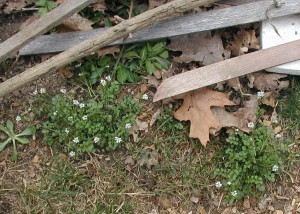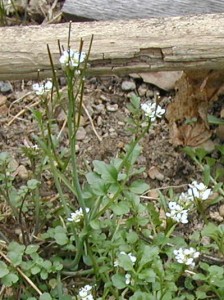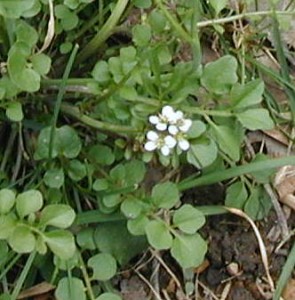I’ve mentioned before that Pennsylvania Bittercress, Cardamine pensylvanica, is already blooming. We saw it first blooming on March 19th, but I suspect the first flowers can be found blooming even earlier. (Photos taken 25 March 2010.)

How do you know that it’s Pennsylvania bittercress? The characteristics that identify it include the shape and arrangement of both leaves and flowers, as well as the very early blooming time. The Peterson Field Guide to Wildflowers states that it will bloom from April to June and that it can be found “nearly throughout” the Northeastern and North-Central United States.
Blooming time alone can’t identify a flowering plant, but it can help eliminate other possibilities from a tentative list. Some plants like dandelion will bloom periodically through out the year, so the time of blooming is not always helpful in identifying a plant. Other flowers will bloom in defined periods which does help in plant identification. For example, skunk cabbage blooms in late winter, sunflowers bloom in the summer, and goldenrods bloom in autumn.
The early Spring blooming of PA Bittercress heralds in the warmer weather. Still, there’s cold weather and possibly snow to fall yet at this time of year, but the little flowers of this member of the mustard family produces seed so fast that it will surely come back next year – even if the mother plant were to be frozen out by extreme March weather.

Take a look at the seeds already produced, near the flower clusters. The seed pods are thin and erect, surrounding the flowers at the tops of the stems. When the seeds have matured, brushing past the plant will forcefully eject the seeds from their pods. Pulling up the plant will also disperse the seeds, so there’s no use trying to make the lawn free of this prolific weed.
The white, four-petaled flowers are small, measuring less than 1/4 inch, but borne in clusters of 4, 5 or more. Here’s a photo looking down on a cluster of 4 flowers —

The rounded basal leaflets are in pairs with the terminal leaflet being slightly longer. Leaflets are narrower and less round on the compound leaves found higher up on the plant.
This Cardamine species, Pennsylvania bittercress, is found in moist areas, near springs or roadside ditches, and in lawns.
![Reblog this post [with Zemanta]](http://img.zemanta.com/reblog_e.png?x-id=19edb1a2-9a90-4ed2-9e27-399fad12a687)